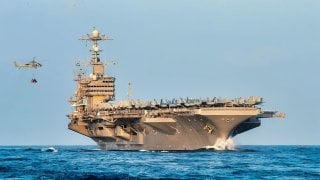U.S. Navy Aircraft Carrier USS John C. Stennis Is Making a Historic Comeback
The USS John C. Stennis (CVN-74), a Nimitz-class nuclear-powered supercarrier, has entered the second phase of its Refueling and Complex Overhaul (RCOH), currently 65% complete and projected to finish in late 2026.
Summary: The USS John C. Stennis (CVN-74), a Nimitz-class nuclear-powered supercarrier, has entered the second phase of its Refueling and Complex Overhaul (RCOH), currently 65% complete and projected to finish in late 2026. Conducted at HII-Newport News Shipbuilding in Virginia, this mid-life overhaul involves flooding the dry dock for ship transit, significant upgrades to propulsion, electronics, and living areas, and testing of the newly installed systems. Once completed, the USS John C. Stennis is expected to be the most technologically advanced carrier in its class, ready to serve beyond its expected 50-year lifespan amidst delays in the Navy's next-generation Ford carriers.
USS John C. Stennis Undergoes Major Overhaul, Set to Become Most Advanced Nimitz-Class Carrier
The USS John C. Stennis (CVN-74) this week began the second phase of a multi-year Refueling and Complex Overhaul.
The Nimitz-class supercarrier’s overhaul is now more than 65% complete, according to the U.S. Navy, and the ship is on track for redelivery in late 2026. HII-Newport News Shipbuilding (NNS) in Newport News, Virginia leads the project. NNS used roughly 100 million gallons of water to flood the dry dock so that the carrier could transit to an outfitting berth at the shipyard, where the remainder of the overhaul work and testing will be completed.
This procedure is typical for aircraft carriers at the midpoint of their life. As part of the process, upgrades to propulsion, infrastructure, electronic systems, and other equipment are usually incorporated. During the next phase of the overhaul, NNS shipbuilders will install the ship’s major components and test its electronics, propulsion, and combat systems. Upgrades to the carrier’s living areas will also be included.
According to Rear Adm. Casey J. Moton, Program Executive Office Aircraft Carriers, “When John C. Stennis redelivers, she’ll be the most technologically advanced Nimitz-class aircraft carrier in the Navy. She’ll bring to the Fleet the highest level of capability across all mission sets.”
Capt. Mark Johnson, manager of the PEO Aircraft Carriers In-Service Aircraft Carrier Program Office, added that “RCOH construction enhances nearly every space and system on the carrier, beyond the most critical requirement to defuel and refuel the ship’s two nuclear reactors and to repair and upgrade the propulsion plant.”
Introducing USS John C. Stennis
As the seventh Nimitz-class nuclear-powered supercarrier to commission in the Navy, the John C. Stennis entered service nearly three decades ago. Like its sister ships, the Stennis is powered by two A4W pressurized water reactors, which can produce a speed of over 30 knots.
This fuel source allows the Nimitz-class ships to operate for over two decades without refueling. While the Stennis has an expected service life of some 50 years, the carrier will probably stay active for longer as the Navy’s next-generation Ford carriers are delayed.
Following the Stennis’ commissioning in December 1995 at Naval Station Norfolk, she conducted an array of carrier qualifications over a two-year period. Perhaps the most significant of these events was the first ever carrier landing of a Boeing F/A-18E/F Super Hornet in 1997.
The Stennis embarked on her first deployment later in the decade and transited the Suez Canal. In 2000, the carrier again deployed to the Persian Gulf, to relieve a fellow Nimitz-class ship in Operation Southern Watch.
In the early 2000s, the Stennis deployed to the U.S. Fifth Fleet area of responsibility in support of Operation Enduring Freedom. Her last deployment abroad took place in 2016, when she sailed to Singapore after completing an annual training exercise in the Philippines. In 2021, the John C. Stennis arrived at Newport News to begin her midlife RCOH.
About the Author: Maya Carlin
Maya Carlin, National Security Writer with The National Interest, is an analyst with the Center for Security Policy and a former Anna Sobol Levy Fellow at IDC Herzliya in Israel. She has by-lines in many publications, including The National Interest, Jerusalem Post, and Times of Israel. You can follow her on Twitter: @MayaCarlin.


